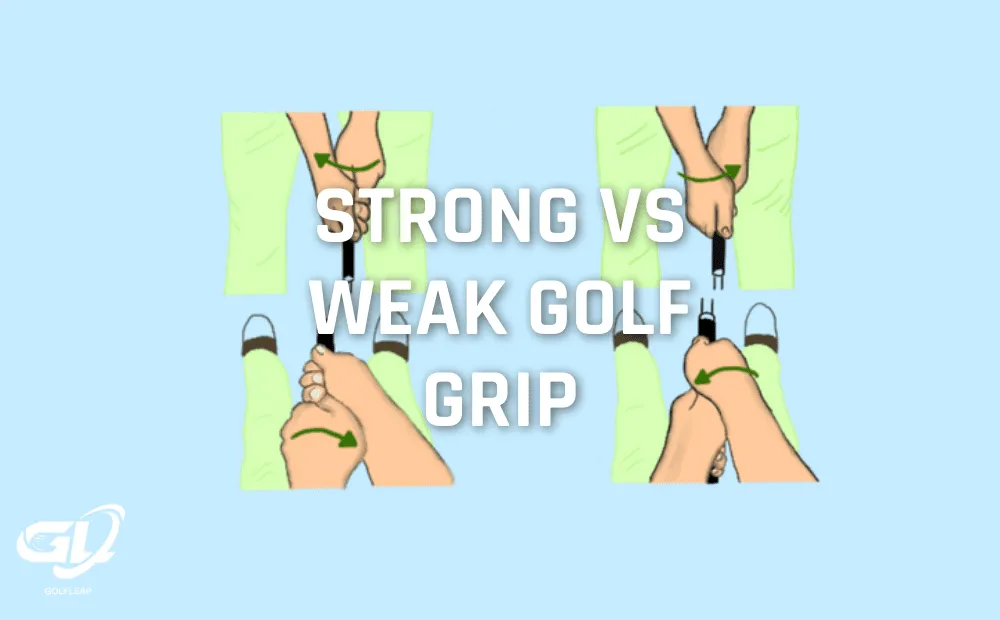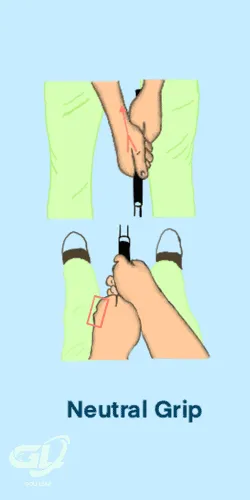
What’s the difference between a strong vs. a weak golf grip?
Mistaking a strong or weak grip with the amount of pressure you apply to the golf club is something we hear everyday. Instead, the strength of your grip is the orientation of your left hand grip and right hand grip from neutral. Each of these three grip strengths (strong, weak, neutral) has its own advantages and disadvantages, but understanding the key differences between each grip will help every golfer (regardless of skill level) understand their swings’ tendencies to better prepare for future rounds and help them hit straighter golf shots.
Our breakdown is meant to serve as an expert guide on how to diagnose your grip yourself, as well as the Pros and Cons of each club gripping style to help players understand these concepts fully and prepare to shoot their lowest scores ever!
Table of Contents
What’s The Difference Between a Strong vs. Weak Golf Grip
The strong and weak golf grip differ in the direction your hands rotate as you hold the grip. With a strong grip, the hands are rotated more clockwise from neutral and are used more to help close the club face on impact. While with the weak grip, the hands are rotated more anti-clockwise from neutral and thus help those who tend to close too much of the club face on impact. This is just the basic idea, to dive deeper into how to grip a strong vs. a weak golf grip, we’ve written a step-by-step guide to gripping the different golf grips.
- A “strong golf grip” is where the golfer’s lead and trailing hands are turned too far away from the target during the initial setup and the swing.
- A “weak golf grip” is where the golfer’s lead and trailing hands are turned too far towards the target during the initial setup and the swing.
- A “neutral territory” between these two grips and hand positionings is known as a “neutral grip.”
This article is focused more on determining which grip style is better!
What The Club Face Should Look Like with a Strong vs. a Weak Golf Grip
Now, I know I said we won’t go deep into what a strong and a weak golf grip are, but I want to make sure this is addressed because I see too many beginners confusing themselves with the club face when trying out these different grip styles.
Theoretically, when you rotate your hands to grip a strong or a weak golf grip, the club face should be closed for a stronger grip and opened for a weaker grip. That’s because you’re rotating from neutral. However, that’s where most beginners stop and get confused because it’s the hands that rotate, not the club face which must stay squared as if it is neutral.
With a stronger golf grip at a squared club face, you are naturally introducing your club face to close more on impact. The same goes for a weaker golf grip, but in its case, it’s a more open face on impact.
About The Strong Golf Grip
To better demonstrate the “strong golf grip,” we’ve included an illustration of a player with a very strong golf grip.
While we believe it’s important for beginner golfers to establish the baseline feeling of a neutral grip when learning the initial and basic golf swing mechanics, there are a ton of professional and high-level golfers who use a strong golf grip to their advantage. In fact, we’d say that a strong grip is often more used than a weak grip.
There are a number of reasons a strong golf grip will feel more “natural” to some golfers when they first pick up a club. The strong grip resembles a baseball grip and forces a player to be more athletic when getting to their impact position, a natural feeling for most athletic people.
You likely noticed from the above illustration that the golfer’s lead hand sits firmly on top of the grip with 3 or more of that hand’s knuckles being visible to the player.

The golfer’s trailing hand sits firmly under the golf club and the line created between the right hand’s thumb and index finger points towards the trailing shoulder or even behind the trailing shoulder.
How to Tell if You Have A Strong Golf Grip
Here’s how you tell if you already have a strong grip:
- Grip the golf club like you normally would.
- Do you see more than two knuckles with your lead hand?
- Does the line created between the right hand’s thumb and index finger points towards the trailing shoulder?
- Does the club feel like it’s resting on your leading hand’s fingers instead of the palm?
- If the answer to these is yes, then welcome to the strong grip family!
These are the three most easily identifiable variables to determine your grip style, but do not be alarmed if any of the above questions describe your grip perfectly!
Professional players and high-level amateurs around the globe have played some amazing golf with a strong grip (as well as a weak grip). That being said, every golfer should be aware of the Pros and Cons of a weak grip to determine if they need to make a change to benefit their consistency and ball-striking!
Pros of a Strong Golf Grip
The most substantial benefit of having a strong grip is eliminating the tendency of slicing the ball (something the overwhelming majority of amateur golfers do).
- A strong grip naturally encourages a draw. Not only does a strong grip help encourage your swing path to be “in-to-out,” but it closes the face at impact which helps slicers of the ball tremendously.
- A strong grip creates a more penetrating ball flight. Players struggling with high and weak slices will naturally close the club face and lower their ball flight with a strong grip, resulting in more distance and controllability if used properly.
- A strong grip eliminates the right side of the golf course (for right-handed golfers). As a golfer with a strong grip myself, knowing I can aim right and have the ball come back towards my intended target allows me to play with double the amount of confidence I had prior to knowing this information about my grip and shot tendencies.
- In some cases, a stronger golf grip can make the club feel lighter and also allow golfers to generate more power! That’s how Rory McIlroy manages to still bomb some of the largest bombs with his golf swing despite being one of the shortest golfers on Tour.
Cons of a Strong Golf Grip
The primary disadvantages of a strong golf grip are the increased chances of hitting a hook or pull.
- A strong grip encourages a golfer to swing “away from their target” and rely on the ball’s spin making it move back towards the intended target (as I described above).
- If used incorrectly or with an incorrect swing path, a strong grip will cause the ball to start left of the target and continue moving left, or the ball will have too much right-to-left spin (for right-handed golfers) and hook off the planet into potential danger.
- A strong grip lowers the attack angle of your clubface at impact and lowers the ball flight naturally. This can work great for getting the ball on the ground quickly but can also hinder a golfer that needs height on their shots to get over danger or attack a green properly.
Should You Use a Strong Grip?
All that said, golfers who can benefit from a stronger golf grip are those who struggle with a pull or slice. Though it’s not a definite solution to correct a sliced golf shot, it definitely helps create a draw-like trajectory. All that said, once you determined that you need a strong grip, it’s up to you to figure out how strong you’d want that grip.
Professional Golfers with a Strong Grip
Tons of professional golfers have played incredibly and won many Majors with a strong golf grip.
- Dustin Johnson
- Zach Johnson
- Bubba Watson
- Freddie Couples
About The Weak Golf Grip
To better demonstrate the “weak golf grip,” we’ve included an illustration of a player with a very weak golf grip.
To first diagnose a golf grip, we must look at a player’s lead hand (for future reference, this means the hand with the glove or the one closest to the target). As you likely noticed, our golfer with a weak grip’s leading hand will likely show one or no knuckles from the golfer’s viewpoint.
Pointing our attention to the golfer’s trailing hand (for right-handed golfers their right hand, left-handed golfers reverse this) the line created between the index finger and thumb points more towards this player’s belt buckle or belly button (ideally this would point between a players head and trailing shoulder).

How to Tell if You Have A Weak Golf Grip
Here’s how you tell if you already have a weak golf grip:
- Grip the club like you normally would then look at your hands and ask:
- With your leading hand, do you see less than two of your knuckles? (Index and Middle Finger knuckles)
- Does the line created by your thumb and index finger on your trailing hand point towards your center or more towards your trailing side?
- Does the club feel like it’s held by your leading hand’s palm instead of the fingers?
- If the answer to these three questions is yes, then you’ve got yourself a weak golf grip!
Pros of a Weak Golf Grip
The most substantial benefit of a weak grip is that it stops a golfer’s hands from over-rotating and becoming too active during the swing.
The most famous example of a golfer switching their grip to a weak style is the legend Ben Hogan (a notorious tinkerer of the golf swing and legend of understanding swing fundamentals).
Hogan got so tired of hitting hooks that he weakened his grip to eliminate that possibility. By doing this, Hogan no longer had to worry about the left side of the golf course and could play a more consistent and anxiety-free game.
- A weak grip will naturally produce a “fade” shot shape (left to right for a right-handed golfer) and stop a hook. Fades land softer on greens and spin less than draws, leading to many faders of the golf ball having more confidence to attack pins and smaller targets more assertively.
*Next is a key fundamental to understanding how to score better for beginner golfers.*
- A weak grip essentially eliminates the left side of the golf course (for Right-handed golfers) by preventing over-rotation of the wrists during the golf swing. By knowing your ball is going to go left thanks to a weak grip(right for a left-handed player), golfers can play with more confidence and pick their targets more precisely.
- A weak grip helps players with slower hips hit the ball straighter! Slow hips tend to cause hooks, and golfers will remedy this by flipping their hands at impact for more speed and distance. A weak grip will force a player missing to the left to prepare for a new miss to the right.
Cons of a Weak Golf Grip
The primary disadvantage of a weak grip is an increased chance of hitting pushes and slices.
- A weak grip often influences the club to be open at impact, which results in the misses we mentioned.
- A weak grip can cause serious problems trying to hit a draw (working the ball right to left for right-handed players) or can make it physically impossible for some golfers.
- A last *potential* disadvantage to a weak grip is an increased height of ball flight. This can be great for players that need an increase in height for more distance, but more height also receives more influence from the wind and can be greatly affected by a poor strike by going further offline.
Should You Use a Weak Grip?
You should use a weak grip if you struggle with a naturally hooked golf shot. Chances are, this will correct your ball flight to make it straighter by making the face more squared than closed-on impact. On top of that, if you’ve got a slower hip rotation in your golf swing (many senior golfers), a weak grip can help you square the face better making the golf ball consistently straighter. Give it a try!
Professional Golfers with a Weak Grip
Many professional golfers play with a weak grip and are primarily faders of the golf ball.
- Jordan Spieth
- Collin Morikawa
- Ben Hogan
- Jim Furyk
Neutral Golf Grip
There is no one “right way” to grip a golf club, but we do recommend that beginner golfers learn the basic golf swing mechanics from the starting point of a neutral grip.
We of course encourage beginner golfers to seek the advice and expertise of an instructing professional if they are able to, but we understand many players don’t have this luxury and will outline how to make a neutral grip below.
Begin by placing your lead hand on the club with the shaft feeling like it’s running up the crease of where your fingers connect to your palm. You should see one to two knuckles on your lead hand from your eye’s perspective, and the line created between your thumb and forefinger should point between your chin and rear shoulder.

Take your trailing hand and place it on the golf club, mirroring the feeling you’ve created with your leading hand, and feeling the club more in your fingers than your palm. The line formed by the trailing hand’s thumb and index finger will be parallel/pointed in the same direction as your leading hand, and both should point between your chin and rear shoulder, somewhere along your trapezius.
Final Thoughts: Strong vs. Weak Golf Grip
Each grip we’ve outlined has its own advantages and disadvantages but understanding how each grip will influence your ball flight and miss-tendencies is a crucial aspect to scoring your best as a golfer.
If you’ve been playing golf for a while and have a tendency to slice the ball, experiment with strengthening your grip and see if that helps avoid that miss.
If you’ve developed the tendency of hooking the ball or hitting the ball too low, experiment with weakening your grip and see if that adds some height and reduces the hook spin your swing naturally adds to the ball.
If you’re a beginner golfer, begin your journey into this endlessly complicated game with a neutral grip and experiment from there to find what makes you feel the most comfortable and confident over the golf ball.
While you’re here, be sure to check out our other breakdowns that will help you understand the game further and shoot your lowest scores this upcoming season!

